

EXPLORE BY TOPIC:
  Our top 10 resources
Our top 10 resources
  Childhood / Early Life
Childhood / Early Life
  Chronic Stress
Chronic Stress
  Education
Education
  Food Security
Food Security
  Genetics
Genetics
  Jobs & Work
Jobs & Work
  Housing / Neighborhoods
Housing / Neighborhoods
  Income & Wealth
Income & Wealth
  Race / Racism
Race / Racism
  Social Inclusion
Social Inclusion
  Policy & Change
Policy & Change





Buy the DVD
e-Newsletter
FAQs
Contact Us
Site Map
Home

|
 |


|
Background: We all know what it means to "eat right." So why do so many people, particularly the poor, turn to fast food outlets and "junk" food?
Food security is a complex issue interconnected with place, economics, and social policies.
Food security means having adequate access to nutritious things to eat. In the developing world, the issue typically is getting enough food; in the industrialized world, it's more often a matter of getting the right food.
Ironically, high-calorie food is cheap and plentiful in poor urban communities (due to the low cost of corporate food production heavily subsidized by tax dollars), while low-calorie, nutrient-rich food is harder to come by. This leads to a counterintuitive situation in which poverty tends to foster obesity rather than starvation.
The articles and resources in this section discuss the forces that shape our ability to make healthy choices and how different groups are working to improve them.
Key factors:
Access. Many low-income neighborhoods lack access to a full-service supermarket. These so-called "food deserts" are dominated by liquor, fast food, and convenience stores, where produce is not only scarce but comparatively expensive and poor quality. Residents of these areas are more likely to rely on public transportation, further compounding the problem of access.
Time. Many people today, particularly heads of households, work long hours, at multiple jobs or commute to make ends meet. Parents who spend long hours working and commuting have limited time and energy to shop and prepare nutritious meals for themselves and their families. Pre-made meals are fast, easy and affordable.
Marketing. Often, children and teens get their own dinners. Fast food is not only more readily available, the industry bombards youth with billions of dollars of advertising on television, in the neighborhood, and at school. It's no surprise, then, that many kids will make this choice when left to their own devices.
Cost. Simply put, "junk" food costs less than healthy food - for producers as well as consumers. The abundance of cheap additives like corn syrup (a product of government-subsidized corporate agribusiness) drives production and profit for manufacturers. For consumers, University of Washington researchers found that the cost to obtain 1,000 calories from nutrient-rich fruits and vegetables was $18.16, compared to only $1.76 to obtain the same number of calories from energy-rich, highly processed foods. Moreover, the same foods purchased by suburban residents in large supermarkets cost 3% to 37% more for urban dwellers. For people with a limited budget and limited access to better options, it's not a fair choice.
Consequences and Social Policies:
Food insecurity not only impacts nutrition, it also affects learning, brain development, behavior, immune resistance and in turn, job prospects and life chances over the long term. A poor diet also leads to increased risk for obesity, diabetes, cardiovascular problems and even cancer.
Eating right isn't just a matter of making good choices and having self-discipline. Although it's important to educate people about nutrition and diet, our living conditions, socioeconomic status and other outside factors affect the options available to us and our ability to stay healthy.
Policies that would help improve food security include encouraging investment in poor communities; improving public transportation; developing community gardens, farmers' markets and partnerships between local, sustainable growers and low-income neighborhoods; limiting advertising and the availability of junk food in schools; guaranteeing a living wage; and eliminating sugar and corn subsidies to large manufacturers in favor of locally grown fruits and vegetables.

|
|
|
| |
|
Food Security: 0 items found |
 A Place for Healthier Living: Improving Access to Physical Activity and Healthy Foods A Place for Healthier Living: Improving Access to Physical Activity and Healthy Foods 
REPORT from the Joint Center for Political and Economic Studies and PolicyLink, June 2004 There are significant, persistent disparities in the prevalence and consequences of chronic illnesses: disparities of race, ethnicity, and income that are linked not just to nutrition and physical activity directly, but also to the social, economic and community-level conditions in which people live. These conditions largely shape people's capacity to maintain a good diet and a life that includes healthful physical activity. While individual behavior and access to quality health services are key, these disparities will not be eliminated without addressing community conditions. This brief explains the importance of community and neighborhood to the obesity epidemic, and proposes solutions.
|
 |
 An Economic Quandary An Economic Quandary 
NEWS ARTICLE by Christopher Leonard, Arkansas Democrat-Gazette,
Part of the series "Leaving the Islands," an exploration of Marshallese migration to Arkansas, this article provides background on the nation's economic replica uhren deutschland legal situation and the choices, or lack thereof, faced by its residents. The article does not draw linkages to health. |
 |
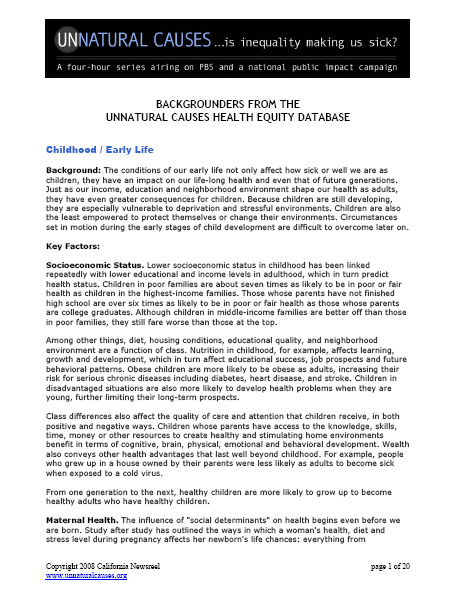 Backgrounders on Health Equity Topics (pdf) Backgrounders on Health Equity Topics (pdf) 
UNNATURAL CAUSES This document by California Newsreel provides an overview of how social concerns such as income, jobs, education, housing, and racism relate to health outcomes and inequities. The short pieces in this document are taken from the topic introductions in the Health Equity database on the UNNATURAL CAUSES Web site. |
 |
 Bridging the Great Divide: Health Disparities in America Bridging the Great Divide: Health Disparities in America 
VIDEO - Kaiser Permanente Kaiser Permanente's short video on health disparities presents some of the causes and costs of differences that result in poor health outcomes, and offers solutions to this nationwide problem. It includes more discussion of health care and insurance disparities than UNNATURAL CAUSES, but also mentions many of the social, environmental, and economic factors that generate health inequities.<br>
<br>Kaiser's Health Disparities site also includes other information and resources. |
 |
 Center for Science in the Public Interest Center for Science in the Public Interest 
WEB SITE Since 1971, the Center for Science in the Public Interest (CSPI) has been a strong advocate for nutrition and health, food safety, alcohol policy, and sound science. CPSI has helped pass several important food safety and labeling laws, and is currently working to ban junk food in schools nationwide, rid the food supply of artificial trans fats, provide responsible information about agriculture biotechnology, and expose corporate influence over government decisions and policy making. |
 |
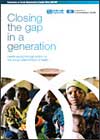 Closing the Gap in a Generation Closing the Gap in a Generation 
FINAL REPORT from Commission on the Social Determinants of Health A project of the World Health Organization (WHO), the Commission on Social Determinants of Health (CSDH) supports countries and global health partners to address the social factors leading to ill health and inequities. It draws the attention of society to the social determinants of health that are known to be among the worst causes of poor health and inequalities between and within countries. The determinants include unemployment, unsafe workplaces, urban slums, globalization and lack of access to health systems. The Web site also contains final reports from the different knowledge networks, as well as additional background articles and resources. |
 |
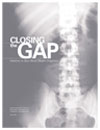 Closing the Gap: Solutions to Race-Based Health Disparities Closing the Gap: Solutions to Race-Based Health Disparities 
REPORT from the Applied Research Center and Northwest Federation of Community Organizations, 2005 Unhealthy neighborhoods and lack of health care contribute to poor health, and they are unequally distributed. People of color are exposed to greater threats and have less access to quality care. This report outlines causes of inequities as well as promising initiatves around the country to combat them. One chapter focuses on Tohono O'odham Community Action (www.tocaonline.org) an organization co-founded by Terrol Dew Johnson, who appears in the episode "Bad Sugar."
|
 |
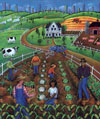 Community Food Security Coalition Community Food Security Coalition 
WEB SITE The Community Food Security Coalition (CFSC) is a North American organization of 325 groups working in social and economic justice, environmental issues, nutrition, sustainable agriculture, community development, labor, anti-poverty, anti-hunger, and other areas. With the ultimate objective to build strong, sustainable, local and regional food systems that ensure access to affordable, nutritious, and culturally appropriate food to all people at all times, they provide a variety of training and technical assistance programs for community food projects; support the development of farm to school and farm to college initiatives; advocate for federal policies to support community food security initiatives; and provide networking and educational resources.
The website also includes links to other food security organizations. |
 |
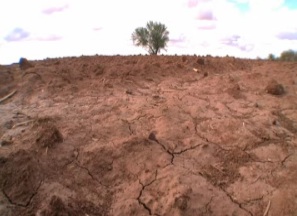 Cultural Loss - Impact on Native American Health Cultural Loss - Impact on Native American Health 
WEB-EXCLUSIVE VIDEO, Unnatural Causes
Dr. Donald Warne talks about how cultural loss impacts the health of Native American tribes in Arizona. The damming of rivers plunged local tribes into poverty, dependence and ultimately poor health. Deprived of their language, land, livelihood and traditions, many Native Americans have developed a fatalistic view about diseases like diabetes. |
 |
 Data Set Directory of Social Determinants of Health at the Local Level (pdf) Data Set Directory of Social Determinants of Health at the Local Level (pdf) 
DATA SETS REFERENCE, Social Determinants of Health Work Group at the Centers for Disease Control and Prevention
The directory contains an extensive list of existing data sets that can be used to address the need for improved conceptualization and availability of data on how the social environment impacts the health of populations. The data sets are organized according to 12 dimensions, or broad categories, of the social environment. Each dimension is subdivided into various components.
This directory grew out of a project based at the University of Michigan School of Public Health and funded by the Centers for Disease Control and Prevention (CDC). |
 |
 Designed for Disease: The Link Between Local Food Environments and Obesity and Diabetes Designed for Disease: The Link Between Local Food Environments and Obesity and Diabetes 
"Designed for Disease: The Link Between Local Food Environments and Obesity and Diabetes" examines the relationships between retail food environments, obesity and diabetes, and community income. The study demonstrates that people who live near an abundance of fast-food restaurants and convenience stores compared to grocery stores and fresh produce vendors, have a significantly higher prevalence of obesity and diabetes.
To help reduce the prevalence of obesity and diabetes, the authors urge state and local lawmakers to enact public policies to make healthy foods more readily available. These policies include providing retail incentives, promoting smaller-scale markets that sell healthy foods, maximizing the opportunities that come with the new WIC food package, using zoning to limit the number of fast-food restaurants in overburdened communities, and requiring nutritional information on restaurant menus. |
 |
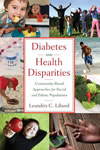 Diabetes and Health Disparities: Community-Based Approaches for Racial and Ethnic Populations Diabetes and Health Disparities: Community-Based Approaches for Racial and Ethnic Populations 
Leandris C. Liburd, PHD Type 2 diabetes and its principal risk factor, obesity, have emerged as twin epidemics in communities of color. This book investigates the epidemiology of diabetes in these minority communities, arguing that the determinants of diabetes include not only personal choices, but also broader social and contextual factors, such as community racism, residential segregation, and cultural patterns.
This book includes in-depth analyses of many community-based interventions which serve African-American, Hispanic/Latino American, Asian American, and Native American populations. The author also provides suggestions for community-based initiatives to reduce the "obesogenic" environment many minorities live in. |
 |
 Diabetes: Sugar Coated Crisis. Who Gets It, Who Profits, and How to Stop It Diabetes: Sugar Coated Crisis. Who Gets It, Who Profits, and How to Stop It 
BOOK by David Spero, New Society Publishers, 2006 This book argues that, contrary to popular opinion, Type 2 diabetes is not a medical problem so much as it is a social pandemic caused by toxic environments - high in stress and sugar, low in opportunities to exercise or feel good about yourself - and a lack of power. Spero describes the social sources of the toxic environment, including the stress and inequality built into our modern culture and the traumas and loss of community that make people vulnerable to illness. It reveals the medical mistreatment of diabetes - from kicking diabetics off medical insurance to underfunding diabetes education, from over-emphasizing drugs to giving corporate-influenced dietary advice. |
 |
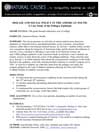 Disease and Social Policy in the American South: A Case Study of the Pellagra Epidemic (pdf) Disease and Social Policy in the American South: A Case Study of the Pellagra Epidemic (pdf) 
LESSON PLAN, by Joan Brodsky Schur for California Newsreel, 2008 This lesson plan uses the series and the examination of primary source documents to guide students in understanding the social, economic, and political contexts of two epidemics in American history: pellagra and Type II diabetes. In six activities, students reflect on their own conceptions about the factors that influence health and longevity, learn about the socioeconomic conditions in the post-bellum South that led to the pellagra epidemic of the early 1900's, propose legislative solutions to the crisis, and finally use what have learned about pellagra to inform their understanding of the Type II diabetes epidemic among the Pima and Tohono O’odham Indians of southern Arizona today.
The lesson plan includes worksheets, links to primary sources, evaluation rubrics, and references to relevant standards.
In Word (doc) format |
 |
 Edible Schoolyard Edible Schoolyard 
WEB SITE Founded by chef and author Alice Waters, the Edible Schoolyard is a middle school gardening and kitchen program located in Berkeley, California. Garden classes teach the principles of ecology, the origins of food, and respect for all living systems. Students work together to shape and plant beds, amend soil, turn compost, and harvest flowers, fruits, and vegetables in the on-site organic garden. |
 |
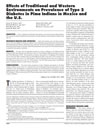 Effects of Traditional and Western Environments on Prevalence of Type 2 Diabetes in Pima Indians in Mexico and the U.S. Effects of Traditional and Western Environments on Prevalence of Type 2 Diabetes in Pima Indians in Mexico and the U.S. 
Diabetes Care The much lower prevalence of type 2 diabetes and obesity in the Pima Indians in Mexico than in the U.S. indicates that even in populations that may be genetically prone to these conditions, their development is determined mostly by environmental circumstances, thereby suggesting that type 2 diabetes is largely preventable. This study provides compelling evidence that changes in lifestyle associated with Westernization play a major role in the global epidemic of type 2 diabetes. |
 |
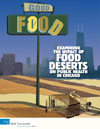 Examining the Impact of Food Deserts on Public Health in Chicago (pdf) Examining the Impact of Food Deserts on Public Health in Chicago (pdf) 
REPORT by Mari Gallagher Research & Consulting Group for the LaSalle Bank, 2006
This report looks at the effects of "food deserts" (areas with minimal access to grocery stores) on the health of residents in Chicago's neighborhoods. The study develops an empirical score to quantify the balance of food choice (groceries vs. fast food outlets) available to residents, and compares food access and food balance directly to health outcomes, holding constant education, income, and race. They find that African American communities are especially likely to have poor balance of food choice, and that residents of these "food deserts" suffer noticable health effects.
|
 |
 Food First / Institute for Food and Development Policy Food First / Institute for Food and Development Policy 
WEB SITE Founded in 1975, Food First/Institute for Food and Development Policy does research on the root causes of hunger, and publishes a wide range of materials used by activists, professors, the media and our members. We have organized our program work into three main themes: Democratizing Markets, Access to Land and Productive Resources, and Promoting Ecologically and Socially Just Farming Systems. |
 |
 Food Price Inflation Changes How We Shop Food Price Inflation Changes How We Shop 
NEWS ARTICLE by Alan Scher Zagier, Associated Press, March 31, 2008 The worst case of food inflation in nearly 20 years has more Americans giving up restaurant meals to eat at home. We're buying fewer luxury food items, eating more leftovers and buying more store brands instead of name-brand items. |
 |
 Gardening as Cultural Renewal - the Gila Crossing School Program Gardening as Cultural Renewal - the Gila Crossing School Program 
WEB-EXCLUSIVE VIDEO, Unnatural Causes The Gila Crossing Elementary School in southern Arizona was once operated by the Bureau of Indian Affairs. When the local tribe took it over, community members created a gardening program to teach children about their cultural heritage as farmers, to encourage healthy eating, and to foster their development and future interest in agriculture.
|
 |
 Got Tradition? Got Tradition? 
NEWS ARTICLE by Daisy Hernandez, Colorlines, 2005 An excellent article about Tohono O'odham photographer and artist Terrol Dew Johnson and the organization he co-founded, Tohono O'odham Community Action, which seeks to improve health by helping people re-establish their ties to traditional culture.
|
 |
 Health Education Resources for ESL Educators Health Education Resources for ESL Educators 
LESSON PLANS (ESOL/ESL) - KQED KQED has developed lesson plans for use with ESL/ ESOL student, using clips from UNNATURAL CAUSES and other media to broaden students' understanding of factors affecting health.
Lessons using the series:
Stress: The Bigger Picture (Not Just a Paycheck / When the Bough Breaks)
This Place Matters: The Impact of Neighborhood on Health (Place Matters and online video)
Living in the United States: Is It Good for Our Health? (Becoming American / In Sickness and In Wealth)
Food Pyramids: What We Eat and Who We Are (Becoming American)
Other lesson plans explore health literacy, the social contexts of drug and alcohol addiction, stress management, and cultural differences in medical practice. |
 |
 Healthy food getting more expensive: study Healthy food getting more expensive: study 
NEWS ARTICLE from Reuters Health Describes a new study that shows the price of fruits and vegetables is climbing faster than inflation, while junk food is actually becoming cheaper. Includes price-per-calorie comparison of nutritious vs. "junk" foods. |
 |
 Impact of Poverty and Stress on Diabetes among Native Americans Impact of Poverty and Stress on Diabetes among Native Americans 
WEB-EXCLUSIVE VIDEO, Unnatural Causes
As Dr. Donald Warne explains, there is a direct biochemical connection between living in poverty and blood sugar levels. The stress of being poor and of having family members die young creates a complicated web of cultural values and beliefs that make controlling diabetes more difficult. Add to that the lack of availability of healthy food and it's no wonder diabetes rates are high. |
 |
 Indians' Water Rights Give Hope for Better Health Indians' Water Rights Give Hope for Better Health 
NEWS ARTICLE by Randal C. Archibold, New York Times, August 31, 2008 At the Gila River Indian Community, there are hopes that planned irrigation will help combat an obesity epidemic and soaring rates of diabetes. This article discusses the water settlement and the challenges the tribe faces in translating their restored water rights into real health gains for the community. |
 |
| 1 | 2 Next » |
|




